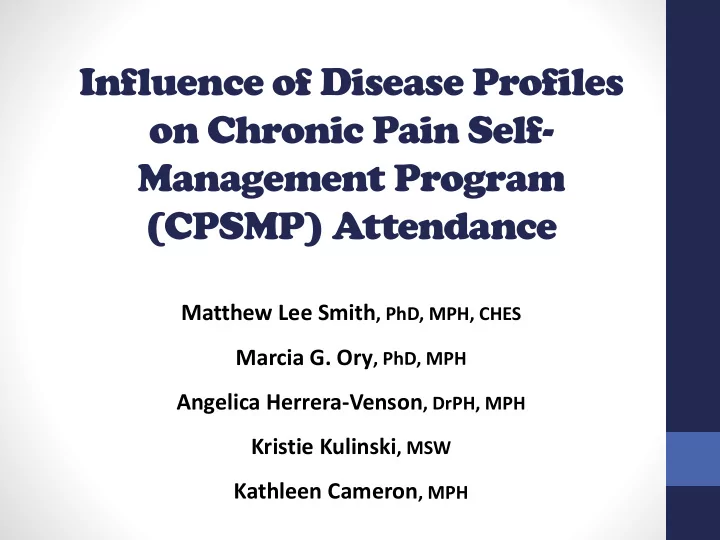

Influence of Disease Profiles on Chronic Pain Self- Management Program (CPSMP) Attendance Matthew Lee Smith , PhD, MPH, CHES Marcia G. Ory , PhD, MPH Angelica Herrera-Venson , DrPH, MPH Kristie Kulinski , MSW Kathleen Cameron , MPH
Partner Recognition
Pain and Aging • About 50% of community-dwelling older adults live with chronic pain • About 80% of those residing in residential facilities • Although common, pain is often under-reported, under- recognized, and under-treated • Difficulty detecting true source • Beliefs that it cannot be treated • Beliefs that it will lead to expensive medications • Pain and aging are multi-determined with contributions across the biopsychosocial spectrum
Sources & Consequences of Pain for Older Adults SOURCES CONSEQUENCES • Degenerative joint disease • Sleep disturbance • Spinal stenosis • Functional decline • Fractures • Depression, anxiety • Pressure ulcers • Poly-pharmacy • Neuropathic pain • Malnutrition • Urinary retention • Increased healthcare utilization • Post-stroke syndrome • Prolonged hospital stays • Improper positioning • Inability to perform roles • Fibromyalgia • Cancer pain • Contractures • Postherpetic neuralgia • Oral/dental sources • Constipation
Opioids Use and Abuse • The U.S. makes up 4.6% of the world’s population but consumes 80% of the world’s opioid supply • More than 214 million opioid prescriptions were written in 2016 • Over 1.9 million Americans are addicted to opioids • 4 out of 5 heroin users started on prescription opioids As the opioid crisis continues to plague America, community-based interventions are needed to help adults manage chronic pain and reduce unnecessary pharmaceutical use
Study Purposes 1. Briefly describe the Chronic Pain Self-Management Program (CPSMP) 2. Describe personal characteristics and workshop attributes associated with the national dissemination of CPSMP from 2010-2016 3. Identify factors associated with successful workshop completion (i.e., attending 4+ of 6 workshop sessions) among CPSMP participants
CPSMP (https://www.selfmanagementresource.com) • Participants gain the knowledge, skills, and necessary support to take control of their health and make healthy lifestyle changes • 6 workshop sessions held once a week • Each session 2 ½ hours, highly interactive • Co-facilitated by two trained leaders, one of whom has an ongoing health condition • Core content: • Symptom management/social role function • Coping techniques (fatigue, frustration, isolation, sleep) • Exercises to build self-efficacy • Problem solving to overcome challenges • Goal setting and action plans
CPSMP: Breaking the Cycle
Data • Data were collected from middle-aged and older adults enrolled in CPSMP nationwide (2010-2016) • Administrative records and a brief baseline questionnaire • Analyses of 4,798 participants with complete data • 506 workshops • 34 states • Data Analyses • Chi-square tests • Independent sample t-tests • Binary logistic regression • Significance: P < 0.05
Measures • Dependent Variable • Workshop attendance: Attending 4+ of 6 sessions • Personal Characteristics • Age, Sex, Race, Ethnicity, Live alone, Rurality • Health Indicators • Self-reported chronic conditions (e.g., heart disease, diabetes) • Workshop Characteristics • Number of participants enrolled in the workshop (0 to 20) • Delivery site type (e.g., healthcare organization, senior center)
Sample Characteristics • On average, 4.4 sessions attended • 29% attended workshops in AAA or Senior Centers • 75% attended 4+ sessions • 24% healthcare organizations • On average, age 67.3 years • 18% residential facilities • 77% female • 11% multi-purpose facilities • 4% Hispanic; 12% African American • 7% faith-based organizations • 51% lived with others • 23% reside in rural area • On average, 2.9 chronic conditions • 60% heart disease • 59% arthritis • 25% diabetes • 22% breathing /lung disease • 19% osteoporosis • 14% cancer
Successful Completion SUCCESSFULLY COMPLETING WORKSHOP SESSIONS (4+ of 6)… • More likely • Female • More chronic conditions • Reside in rural area • Less likely (relative to attending workshops in AAA senior center) • Healthcare organization • Residential facility • Educational institution • Tribal organizations
Factors Associated with Successful Workshop Completion 95% CI P OR Lower Upper Number of Self-Reported Chronic Conditions 0.043 1.04 1.00 1.09 Age 0.267 1.00 1.00 1.01 Male -- 1.00 -- -- Female 0.011 1.22 1.05 1.43 Non-Hispanic -- 1.00 -- -- Hispanic 0.372 0.85 0.59 1.22 Race: White -- 1.00 -- -- Race: African American 0.853 1.02 0.83 1.26 Race: Asian/Pacific Islander 0.723 0.90 0.51 1.60 Race: American Indian/Alaska Native 0.953 1.02 0.59 1.77 Race: Hawaiian 0.185 0.41 0.11 1.54 Race: Other/Multiple 0.736 1.06 0.76 1.48 Live Alone -- 1.00 -- -- Live with Others 0.869 0.99 0.86 1.14 Rurality: Urban -- 1.00 -- -- Rurality: Rural 0.001 1.33 1.11 1.58 Number of Participants Enrolled in Workshop 0.498 1.00 0.98 1.01 Delivery Type: AAA/Senior Center -- 1.00 -- -- Delivery Type: Healthcare Organization <0.001 0.67 0.55 0.81 Delivery Type: Residential Facility <0.001 0.56 0.46 0.69 Delivery Type: Multi-Purpose Organization 0.050 0.79 0.62 1.00 Delivery Type: Faith-Based Organization 0.613 0.92 0.68 1.25 Delivery Type: Educational Institution 0.005 0.44 0.25 0.79 Delivery Type: Governmental Agency 0.260 0.70 0.38 1.30 Delivery Type: Workplace 0.280 2.27 0.51 10.08 Delivery Type: Tribal Organization 0.043 0.39 0.16 0.97 Delivery Type: Other 0.018 0.72 0.55 0.95 * Referent Group: Attending 1 to 3 workshop sessions
Conclusion • High completion among participants with complex disease profiles and in rural areas is encouraging because these populations are disproportionately impacted by the opioid crisis • Workshop location matters • Strategic diversification of delivery infrastructure • Strategic recruitment and retention plans • Efforts are needed to determine the effectiveness of CPSMP as an alternative to pharmaceutical interventions for adults with chronic pain • Complement to (or complemented by) other pain treatments
THANK YOU! Matthew Lee Smith, PhD, MPH, CHES, FAAHB, FGSA Center for Population Health and Aging Texas A&M University The University of Georgia matthew.smith@tamhsc.edu
Recommend
More recommend